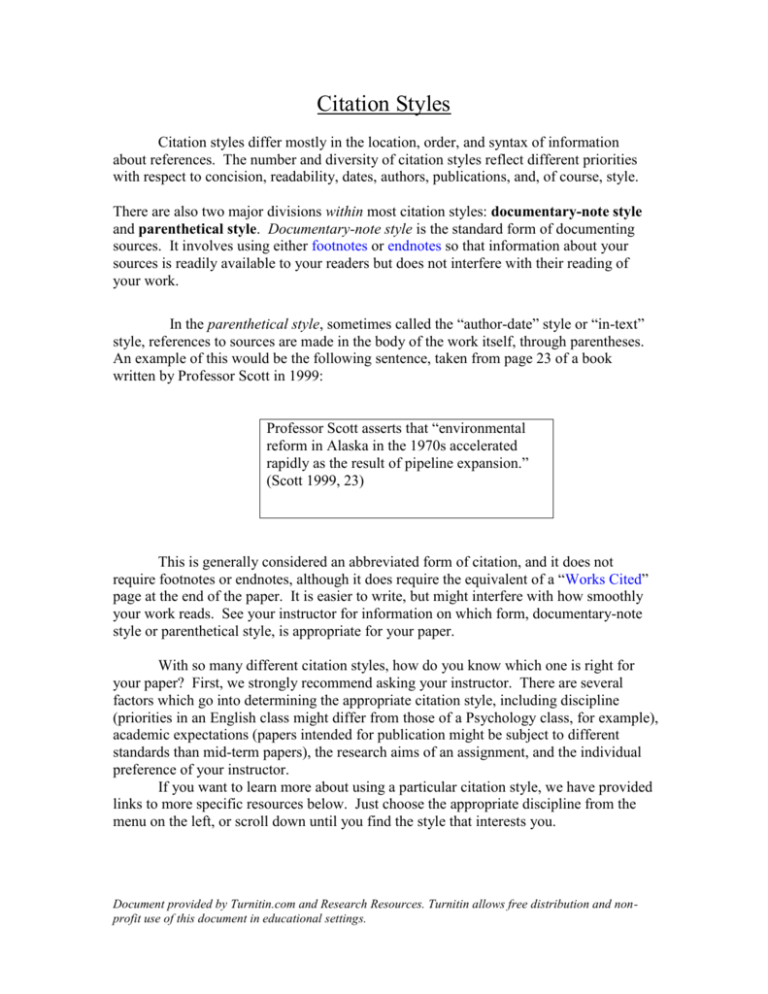Citation Styles - Plagiarism.org
advertisement

Citation Styles Citation styles differ mostly in the location, order, and syntax of information about references. The number and diversity of citation styles reflect different priorities with respect to concision, readability, dates, authors, publications, and, of course, style. There are also two major divisions within most citation styles: documentary-note style and parenthetical style. Documentary-note style is the standard form of documenting sources. It involves using either footnotes or endnotes so that information about your sources is readily available to your readers but does not interfere with their reading of your work. In the parenthetical style, sometimes called the “author-date” style or “in-text” style, references to sources are made in the body of the work itself, through parentheses. An example of this would be the following sentence, taken from page 23 of a book written by Professor Scott in 1999: Professor Scott asserts that “environmental reform in Alaska in the 1970s accelerated rapidly as the result of pipeline expansion.” (Scott 1999, 23) This is generally considered an abbreviated form of citation, and it does not require footnotes or endnotes, although it does require the equivalent of a “Works Cited” page at the end of the paper. It is easier to write, but might interfere with how smoothly your work reads. See your instructor for information on which form, documentary-note style or parenthetical style, is appropriate for your paper. With so many different citation styles, how do you know which one is right for your paper? First, we strongly recommend asking your instructor. There are several factors which go into determining the appropriate citation style, including discipline (priorities in an English class might differ from those of a Psychology class, for example), academic expectations (papers intended for publication might be subject to different standards than mid-term papers), the research aims of an assignment, and the individual preference of your instructor. If you want to learn more about using a particular citation style, we have provided links to more specific resources below. Just choose the appropriate discipline from the menu on the left, or scroll down until you find the style that interests you. Document provided by Turnitin.com and Research Resources. Turnitin allows free distribution and nonprofit use of this document in educational settings. Humanities Chicago Writer’s Handbook: Chicago Style Documentation http://www.wisc.edu/writing/Handbook/DocChicago.html Quick Reference Guide to the Chicago Style http://www.library.wwu.edu/ref/Refhome/chicago.html Excellent FAQ on Usage in the Chicago Style http://www.press.uchicago.edu/Misc/Chicago/cmosfaq/ Online! Guide to Chicago Style http://www.bedfordstmartins.com/online/cite7.html MLA (Modern Language Association) Writer’s Handbook: MLA Style Documentation http://www.wisc.edu/writing/Handbook/DocMLA.html The Documentation Style of the Modern Language Association http://www.newark.ohio-state.edu/~osuwrite/mla.htm MLA Citation Style http://campusgw.library.cornell.edu/newhelp/res_strategy/citing/mla.html Online! Guide to MLA Style http://www.bedfordstmartins.com/online/cite5.html Useful Guide to Parenthetical Documentation http://www.geocities.com/Athens/Acropolis/1623/document.html Turabian (an academic style that works in other disciplines as well) Turabian bibliography samples (Ithaca College Library). Based on the 6th edition of Turabian's Manual. Turabian Style: Sample Footnotes and Bibliographic Entries (6th edition) (Bridgewater State College) Turabian style guide: (University of Southern Mississippi Libraries) Turabian Citation Style Examples (Northwest Missouri State University Sciences ACS (American Chemical Society) Document provided by Turnitin.com and Research Resources. Turnitin allows free distribution and nonprofit use of this document in educational settings. ACS Style Sheet http://www.lehigh.edu/~inhelp/footnote/acs.html ACS Books Reference Style Guidelines http://pubs.acs.org/books/references.shtml AMA (American Medical Society) AMA Style Guide http://healthlinks.washington.edu/hsl/styleguides/ama.html AMA Documentation Style http://rx.stlcop.edu/wcenter/AMA.htm AMA Citation Style http://www.liu.edu/cwis/cwp/library/workshop/citama.htm CBE (Council of Biology Editors) Writer’s Handbook: CBE Style Documentation http://www.wisc.edu/writetest/Handbook/DocCBE6.html Online! Guide to CBE Style http://www.bedfordstmartins.com/online/cite8.html CBE Style Form Guide http://www.lib.ohio-state.edu/guides/cbegd.html IEEE (Institute of Electrical and Electronics Engineers) Handbook: Documentation IEEE Style http://www.ecf.utoronto.ca/~writing/handbook-docum1b.html Sample IEEE Documentation Style for References http://www.carleton.ca/~nartemev/IEEE_style.html Electrical Engineering Citation Style http://www.lehigh.edu/~inhelp/footnote/footee.html NLM (National Library of Medicine) NLM Style Guide http://healthlinks.washington.edu/hsl/styleguides/nlm.html Citing the Internet: A Brief Guide http://nnlm.gov/pnr/news/200107/netcite.html Document provided by Turnitin.com and Research Resources. Turnitin allows free distribution and nonprofit use of this document in educational settings. National Library of Medicine Recommended Formats for Bibliographic Citation (PDF format) http://www.nlm.nih.gov/pubs/formats/internet.pdf Vancouver (Biological Sciences) Introduction to the Vancouver Style http://www.lib.monash.edu.au/vl/cite/citeprvr.htm Vancouver Style References http://www.library.uq.edu.au/training/citation/vancouv.html Detailed Explanation of the Vancouver style http://www.acponline.org/journals/annals/01jan97/unifreqr.htm Social Sciences AAA (American Anthropological Association) Citations and Bibliographic Style for Anthropology Papers http://www.usd.edu/anth/handbook/bib.htm AAA Style Handbook (PDF format) http://www.aaanet.org/pubs/style_guide.pdf APA (American Psychological Association) Writer’s Handbook: APA Style Documentation http://www.wisc.edu/writing/Handbook/DocAPA.html APA Style Guide http://www.lib.usm.edu/~instruct/guides/apa.html Bibliography Style Handbook (APA) http://www.english.uiuc.edu/cws/wworkshop/bibliography_style_handbookap a.htm APA Style Electronic Format http://www.westwords.com/guffey/apa.html Online! Guide to APA Style http://www.bedfordstmartins.com/online/cite6.html APA Style.org http://www.apastyle.org/elecref.html APSA (American Political Science Association) Document provided by Turnitin.com and Research Resources. Turnitin allows free distribution and nonprofit use of this document in educational settings. Writer’s Handbook: APSA Documentation http://www.wisc.edu/writing/Handbook/DocAPSA.html Legal Style Cornell University’s Introduction to Basic Legal Citation http://www.law.cornell.edu/citation/citation.table.html Legal Citation: Using and Understanding Legal Abbreviations http://qsilver.queensu.ca/law/legalcit.htm Legal Research and Citation Style in the USA http://www.rbs0.com/lawcite.htm Other: General info on citing web documents http://www.lib.berkeley.edu/TeachingLib/Guides/Internet/Style.html Recommended Multi-Style Links http://www.aresearchguide.com/styleguides.html http://www.dianahacker.com/resdoc/ Document provided by Turnitin.com and Research Resources. Turnitin allows free distribution and nonprofit use of this document in educational settings.





